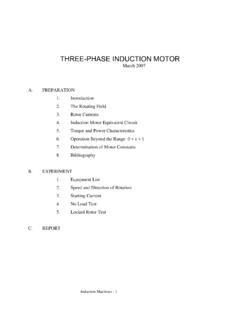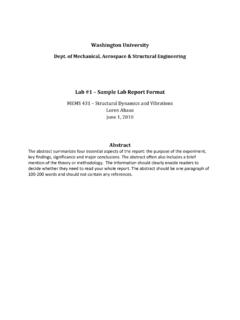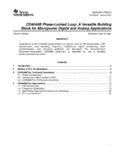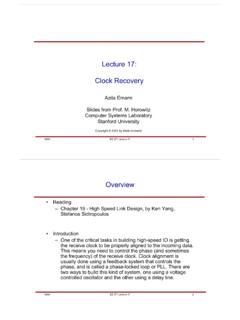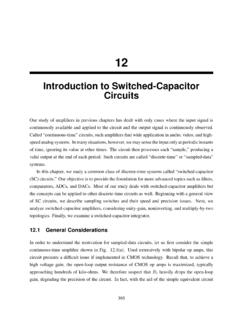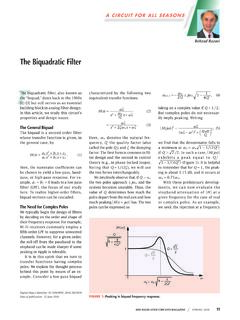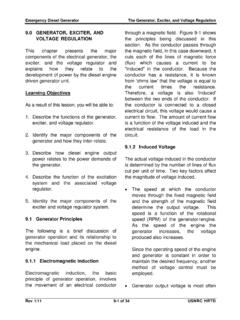Transcription of CIRCUITS LABORATORY EXPERIMENT 9 Operational Amplifiers
1 CIRCUITS LABORATORY EXPERIMENT 9 Operational Amplifiers INTRODUCTION An Operational amplifier ("op amp") is a direct-coupled, differential-input, high-gain voltage amplifier, usually packaged in the form of a small integrated circuit . The term " Operational " dates back to the early days of analog computers when these devices were employed in CIRCUITS that performed mathematical operations such as addition, subtraction, integration, and the solution of differential equations. Today's op amps are used in a much wider variety of CIRCUITS and operate at considerably lower voltages and powers; however, the name remains. The linear circuit which forms the heart of the Operational amplifier is a fairly complicated device consisting of many (30 or more) active and passive devices integrated into silicon. (See schematic diagram in Section at the end of this exercise). Such a complex device requires a team of experienced engineers many months to design!
2 The beauty of Operational Amplifiers , however, is that to first order the input-output characteristics are very simple; the circuit designer using the op amp need not be overly concerned with the inner workings of the thing and can treat it like a "black box" with certain specified and very desirable properties. As such, the modern Operational amplifier is a very useful and versatile building block for thousands of CIRCUITS in applications as diverse as audio, video, communications, process control, instrumentation, and biomedicine. 9 - 1 IDEAL CHARACTERISTICS In this EXPERIMENT , we will be concerned only with the "ideal" Operational amplifier. It is this model, which is the simplest to analyze and which describes the operation that the circuit designer would consider "perfect" were it not for real-world limitations. The symbol for an Operational amplifier is shown in Figure V+ and V- are the input Figure : Operational amplifier symbols.
3 Pin numbers are those of a 741 eight pin dual-inline package. voltages and Vo is the output voltage. These are related by the simple expression Vo = Ao (V+ - V-), ( ) where Ao is the open-loop voltage gain and +VCC and VCC are the positive and negative DC power supply voltages, respectively. There is no internal "ground" or "common" connection; voltages are measured relative to the common connection of the two power supplies. The numbers on the diagram refer to the pin numbers on the 741 integrated circuit (IC) package as shown in Figure The pin numbers and the supply voltages are usually omitted in circuit diagrams as long as there is no ambiguity. Pin 8 is not used. Pins 1 and 5 do serve a useful purpose, but they will not be considered in this lab. 9 - 2 Figure : A741 Operational amplifier integrated circuit package The ideal Operational amplifier is characterized by the following three properties: (1) The open-loop voltage gain Ao is very high.
4 Typically, Ao 105 and, in most simple analyses, you can assume Ao = . (2) The input impedance Ri is very high and can be assumed to be infinite. This means that there is no current into the op amp at input ports V+ and V- . (3) The output impedance Ro is very low and can usually be assumed to be 0 . This means that the output will drive any load without any drop in output voltage. Of course, there are limitations to the above characteristics, especially with regard to (3). The output voltage vo is limited to some significant fraction of the power supply voltage; the output current io is limited internally so that it does not overheat and destroy the device. However, for the range of voltages and currents to be experienced in this lab, these are very good approximations and you may assume them to hold. When designing CIRCUITS with op amps, one never uses the op amp by itself as a high-gain amplifier. The gain is too high and the transfer function too non-linear.
5 Instead, 9 - 3 one designs practical CIRCUITS by using negative feedback from the output to the input. This concept will be emphasized throughout this lab. Fig. shows the input-output characteristics of a typical op amp. When the differential input voltage (V+ - V-) is in the range where the slope = Ao , the output vo is equal to AO (V+ - V-); otherwise the output is saturated at Vsat. The "trick" in designing linear op amp CIRCUITS is to use of negative feedback to always force (V+ - V-) to be suf -ficiently small so that the amplifier is operating in that very narrow linear region. Figure : Ideal op amp input-output characteristic. There is a simple algorithm for the analysis of an op amp circuit . This algorithm is valid only when there is some path from Vo to V-, , negative feedback is being used to force the op amp to operate in its linear region.
6 (1) Assume that the input currents to the op amp are zero. (2) Assume that the differential input voltage is zero and (this is the crucial part) that the output vo always adjusts itself to force the differential input voltage to be zero, which is called a virtual short. 9 - 4 (3) If for whatever reason (2) cannot be satisfied, then the output voltage is Vsat, depending on the polarity of the differential input. Let us apply this algorithm to the simplest op amp circuit of all: the unity gain Figure : Operational amplifier connected as a voltage follower voltage follower of Figure The input voltage is Vi,. The virtual short forces v- = v+ and, therefore, Vo = Vi. Hence, it is termed a voltage follower. Now you may be thinking that this is a circuit that serves no function since the output voltage merely equals the input voltage. On the contrary, this circuit acts as a buffer between Vi and Vo.
7 The input may have a high source impedance or be incapable of providing any significant power. Examples are a microphone or guitar pick-up. Here the input supplies no power at all, since i = 0. Instead, it is the op amp which provides current and therefore power to the load resistor, RL, in such a way that Vo = Vi. Of course, this power is ultimately derived from the power supply via VCC. In this LABORATORY you will assemble and test a variety of simple CIRCUITS which are built around Operational Amplifiers . These have been grouped into three categories: (1) inverting and non-inverting Amplifiers , (2) integrators and differentiators, and (3) function generators. The following section contains some general information on assembling op amp CIRCUITS . Read it carefully before building anything! 9 - 5 v+ v- Operational AMPLIFIER CIRCUITS - GENERAL INFORMATION It is assumed that you are familiar with assembling CIRCUITS using the solderless wiring fixture and ordinary passive components.
8 The 741 IC op amp can also be inserted in this fixture for building op amp CIRCUITS . Insert the 741 integrated circuit so that the pins straddle the center horizontal gap in the wiring fixture and the notch is to the left. The pins are numbered 1 through 8, counter-clockwise beginning with the pin at the lower left. All Operational Amplifiers require an external power supply to operate. The 741 requires two power supplies, one positive and one negative. This will not be shown on subsequent diagrams, but is always assumed. Use the left power supply for +16 V, and the right for -16 V. Connect the negative floating terminal on the left power supply to chassis ground, and connect the positive floating terminal on the right power supply to chassis ground. Use cables with banana plug connectors to supply the +16V, -16V, and ground to separate terminals on your solderless wiring fixture.
9 Be sure to connect the ground cable to the ground terminal on the fixture. Then connect the +16 V to pin 7 and the -16 V to pin 4 of the 741. Although there is no connection for ground on the 741 IC, you will use chassis ground as a reference point later in your CIRCUITS . Do not turn on the power supplies until after you have made these connections. In general, it is a good idea not to assemble any CIRCUITS with the power supplies on. Pins 1, 5, and 8 should be left disconnected. Once you have inserted the 741 op amp in your wiring fixture and connected the power supplies, it should be possible to leave this particular configuration assembled for the rest of the lab. 9 - 6 EQUIPMENT LIST Solderless Breadboard Cables & Wires 741 IC Operational Amplifier Several 1/4-Watt Resistors Decade Capacitor Box (0-10 F) 9V Battery INVERTING AND NON-INVERTING Amplifiers Non-Inverting Amplifier - circuit Using the 741 op amp with power supplies connected as described Section 2, page , assemble circuit as shown.
10 Figure : Non-inverting amplifier circuit The input- output relationship for this circuit is given by ( ) Start with Ri = 10 k and Rf = 33 k . Before inserting resistors Ri and Rf , record and measure their actual resistance using the DMM. Use the function generator 9 - 7 iifoVRRV +=1 LOW OUTPUT to supply a 1 kHz V peak-to-peak sine wave to the input (Vi) to pin 3. Use oscilloscope CH1 to measure Vi and CH2 to measure Vo. You may find it useful to trigger the oscilloscope sweep using the function generator SYNC OUTPUT as an external trigger. Observe and record the input and output voltages using the oscilloscope noting the phase relationship, peak-to-peak voltages and period. Now, measure the rms values of the input and output voltages.

